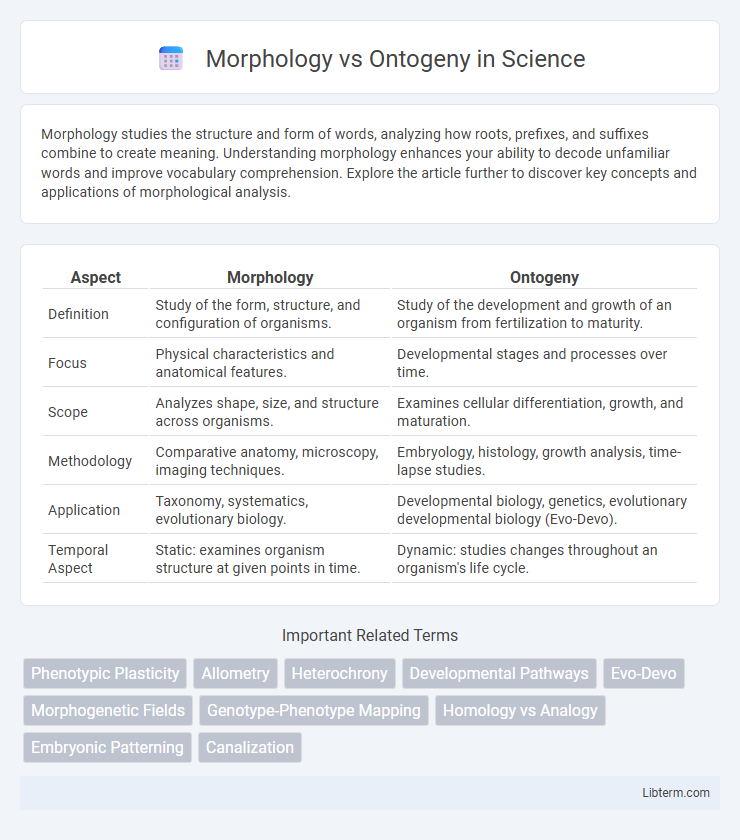Morphology studies the structure and form of words, analyzing how roots, prefixes, and suffixes combine to create meaning. Understanding morphology enhances your ability to decode unfamiliar words and improve vocabulary comprehension. Explore the article further to discover key concepts and applications of morphological analysis.
Table of Comparison
| Aspect | Morphology | Ontogeny |
|---|---|---|
| Definition | Study of the form, structure, and configuration of organisms. | Study of the development and growth of an organism from fertilization to maturity. |
| Focus | Physical characteristics and anatomical features. | Developmental stages and processes over time. |
| Scope | Analyzes shape, size, and structure across organisms. | Examines cellular differentiation, growth, and maturation. |
| Methodology | Comparative anatomy, microscopy, imaging techniques. | Embryology, histology, growth analysis, time-lapse studies. |
| Application | Taxonomy, systematics, evolutionary biology. | Developmental biology, genetics, evolutionary developmental biology (Evo-Devo). |
| Temporal Aspect | Static: examines organism structure at given points in time. | Dynamic: studies changes throughout an organism's life cycle. |
Introduction to Morphology and Ontogeny
Morphology studies the structure, shape, and form of organisms, examining physical attributes such as bones, muscles, and organs to understand evolutionary relationships and functional adaptations. Ontogeny focuses on the development of an individual organism from fertilization through maturation, analyzing cellular differentiation, growth patterns, and morphological changes over time. Integrating morphological features with ontogenetic data provides insight into evolutionary processes and developmental biology.
Defining Morphology: Structure and Form
Morphology studies the structure and form of organisms, analyzing physical features such as shape, size, and arrangement of tissues and organs. It provides detailed insights into anatomical patterns and structural variations that define different species. Morphological traits serve as fundamental criteria for classification, evolutionary studies, and understanding organismal function.
Understanding Ontogeny: Development Over Time
Ontogeny refers to the development of an individual organism from fertilization to maturity, highlighting changes in structure, function, and behavior over time. Morphology focuses on the form and structure of organisms at specific stages, while ontogeny emphasizes the dynamic progression and sequence of developmental events. Understanding ontogeny involves studying genetic, cellular, and environmental factors that influence growth patterns and differentiation throughout an organism's lifecycle.
Key Differences Between Morphology and Ontogeny
Morphology studies the form and structure of organisms, analyzing specific physical traits such as shape, size, and arrangement of parts, whereas ontogeny examines the developmental history of an organism from fertilization to maturity, focusing on growth processes and life cycle stages. Morphology primarily deals with static features observable at a particular life stage, while ontogeny involves dynamic changes occurring over time throughout an organism's lifespan. Key differences include morphology's emphasis on anatomical characteristics versus ontogeny's focus on temporal development and functional changes.
The Role of Genetics in Morphology and Ontogeny
Genetics plays a crucial role in morphology by determining the structural features and physical forms encoded within an organism's DNA, shaping traits such as size, shape, and anatomical configuration. In ontogeny, genetic expression governs the developmental processes from embryo to adult, influencing cell differentiation, growth patterns, and the timing of developmental stages. Variations in gene regulation and mutation can lead to significant phenotypic diversity, affecting both morphological outcomes and ontogenetic pathways.
Environmental Influences on Morphological and Ontogenetic Changes
Environmental factors such as temperature, nutrient availability, and habitat conditions directly influence morphological traits and ontogenetic development in organisms, driving phenotypic plasticity. Morphological changes, including alterations in size, shape, and structural features, often result from adaptive responses to environmental stresses during critical ontogenetic stages. Ontogeny, or the developmental trajectory from embryo to adult, is modulated by these environmental signals, affecting gene expression patterns and ultimately shaping organismal form and function.
Case Studies: Morphology vs Ontogeny in Nature
Morphology examines the structural features of organisms, while ontogeny studies their developmental processes from embryo to maturity. Case studies on amphibians reveal how morphological changes during ontogeny, such as limb formation, adapt to environmental demands. Insects like butterflies showcase distinct morphological stages that correlate with ontogenetic shifts, highlighting evolutionary adaptations in natural habitats.
Evolutionary Implications of Morphology and Ontogeny
Morphology reveals evolutionary adaptations through the study of organismal form and structural changes across species, highlighting phylogenetic relationships and functional traits shaped by natural selection. Ontogeny tracks individual developmental processes from embryo to adult, providing insights into evolutionary mechanisms via heterochrony and developmental plasticity that influence morphological diversification. Together, morphology and ontogeny inform evolutionary biology by linking developmental pathways with phenotypic variation and species' evolutionary trajectories.
Applications in Research and Biotechnology
Morphology studies the structure and form of organisms, providing critical insights for genetic engineering and developmental biology by enabling precise identification of phenotypic traits. Ontogeny examines the developmental processes from embryo to adult, crucial for regenerative medicine and stem cell research to understand differentiation pathways. Combining morphology and ontogeny facilitates advanced biotechnological applications, including tissue engineering and evolutionary developmental biology (evo-devo) research.
Future Perspectives in Morphological and Ontogenetic Studies
Advancements in imaging technologies and computational modeling are set to revolutionize morphological and ontogenetic studies by enabling precise, real-time analysis of developmental processes at cellular and molecular levels. Integration of multi-omics data with ontogenetic timelines will enhance understanding of gene expression patterns driving morphological changes, facilitating predictive models of growth and differentiation. Emerging fields such as single-cell genomics and artificial intelligence will provide unprecedented insights into the dynamic interplay between genetic regulation and morphological evolution, opening new avenues for developmental biology and regenerative medicine.
Morphology Infographic

 libterm.com
libterm.com